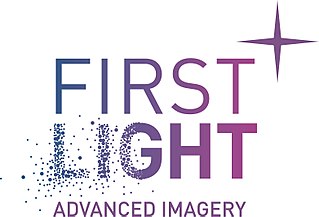
Photonics is a branch of optics that involves the application of generation, detection, and manipulation of light in form of photons through emission, transmission, modulation, signal processing, switching, amplification, and sensing. Photonics is closely related to quantum electronics, where quantum electronics deals with the theoretical part of it while photonics deal with its engineering applications. Though covering all light's technical applications over the whole spectrum, most photonic applications are in the range of visible and near-infrared light. The term photonics developed as an outgrowth of the first practical semiconductor light emitters invented in the early 1960s and optical fibers developed in the 1970s.
Optica is a professional society of individuals and companies with an interest in optics and photonics. It publishes journals, organizes conferences and exhibitions, and carries out charitable activities.

Rodenstock GmbH is a German manufacturer of ophthalmic lenses and spectacle frames. The company, which was founded by Thuringian Josef Rodenstock in 1877, is headquartered in Munich.
SPIE is an international not-for-profit professional society for optics and photonics technology, founded in 1955. It organizes technical conferences, trade exhibitions, and continuing education programs for researchers and developers in the light-based fields of physics, including: optics, photonics, and imaging engineering. The society publishes peer-reviewed scientific journals, conference proceedings, monographs, tutorial texts, field guides, and reference volumes in print and online. SPIE is especially well-known for Photonics West, one of the laser and photonics industry's largest combined conferences and tradeshows which is held annually in San Francisco. SPIE also participates as partners in leading educational initiatives, and in 2020, for example, provided more than $5.8 million in support of optics education and outreach programs around the world.

An autocollimator is an optical instrument for non-contact measurement of angles. They are typically used to align components and measure deflections in optical or mechanical systems. An autocollimator works by projecting an image onto a target mirror and measuring the deflection of the returned image against a scale, either visually or by means of an electronic detector. A visual autocollimator can measure angles as small as 1 arcsecond, while an electronic autocollimator can have up to 100 times more resolution.
The European Optical Society (EOS), founded in 1991, is a European organisation for the development of the science of optics. Membership is open to national optical societies, individuals, companies, organisations, educational institutions, and learned and professional societies. EOS runs international conferences; lobbies for optical science at European level; offers a focus for collecting and disseminating knowledge in the field, and publishes the online journal JEOS:RP.

The Institute of Optics is a department and research center at the University of Rochester in Rochester, New York. The institute grants degrees at the bachelor's, master's and doctoral levels through the University of Rochester School of Engineering and Applied Sciences. Since its founding, the institute has granted over 2,500 degrees in optics, making up about half of the degrees awarded in the field in the United States. The institute is made up of 20 full-time professors, 12 professors with joint appointments in other departments, 10 adjunct professors, 5 research scientists, 11 staff, about 170 undergraduate students and about 110 graduate students.

IPG Photonics is an American manufacturer of fiber lasers. IPG Photonics developed and commercialized optical fiber lasers, which are used in a variety of applications including materials processing, medical applications and telecommunications. IPG has manufacturing facilities in the United States, Germany, Russia and Italy.
Ophir Optronics Solutions is a multinational company that sells optronics solutions. The company develops, manufactures and markets infrared (IR) optics and laser measurement equipment. Founded in 1976, the company was traded on the Tel Aviv Stock Exchange from 1991 until it was acquired, and was a constituent of its Tel-tech index. Headquartered in the Har Hotzvim industrial park in Jerusalem, Israel Ophir owns a 100,000-square-foot (9,300 m2) complex that includes the group's main production plant. Ophir has additional production plants in North Andover, Massachusetts and Logan, Utah in the US and sales offices in the US, Japan and Europe. In 2006, Ophir acquired Spiricon Group, a US-based company in the beam-profiling market. Ophir's sales increased sharply from $45 million in 2005 to $74 million in 2007. During 2007, Ophir established a Swiss-based subsidiary to market lenses and components for surveillance and imaging systems in Europe. In May 2010, Ophir acquired Photon Inc., another US-based beam-profiling company. Newport Corporation, a global supplier in photonics solutions, completed its acquisition of the Ophir company in October 2011. In 2016, metrology firm MKS Instruments bought Newport Corporation, including the Ophir brand, for $980 million.
EKSPLA is a laser and laser electronics manufacturing company based in Vilnius, Lithuania. EKSPLA is known for their lasers and laser systems, as well as other photonics components. The company is supplying their products for scientific, OEM & industrial applications.
Optics Valley is a region in southern Arizona, centered on Tucson, that is home to a high concentration of optics companies spawned by research at the University of Arizona. Based on the idea of a technology cluster, akin Silicon Valley, Optics Valley is known not only for its optics industry and research but also for the astronomical observatories located in the mountains of southern Arizona. These observatories benefit from clear skies and isolated peaks, creating superior observing conditions.

Francisco Javier "Frank" Duarte is a laser physicist and author/editor of several books on tunable lasers.
The European Photonics Industry Consortium (EPIC) is a not-for-profit association with headquarters in Paris, France. EPIC serves the photonics community through a regular series of workshops, market studies and partnering. EPIC focuses its actions on LEDs and OLEDs for lighting, optical fiber telecommunications, laser manufacturing, sensors, photovoltaics and photonics for life sciences. EPIC coordinates its activities internationally through its membership in the International Optoelectronics Association.

Susan Nicole Houde-Walter is an academic and technical executive in the field of optics. She was professor of optics at the University of Rochester from 1987-2005. She used to run LaserMaxDefense, a manufacturer of laser equipment for military and law enforcement. She served as president of the Optical Society in 2005 and has travelled extensively with the US military. Dr. Houde-Walter served as director of the Chester F. Carlson Center for Imaging Science at the Rochester Institute of Technology. from 2022 to 2023.

MACOM Technology Solutions is a developer and producer of radio, microwave, and millimeter wave semiconductor devices and components. The company is headquartered in Lowell, Massachusetts, and in 2005 was Lowell's largest private employer. MACOM is certified to the ISO 9001 international quality standard and ISO 14001 environmental standard. The company has design centers and sales offices in North America, Europe, Asia and Australia.
Thomas Baer is the executive director of the Stanford Photonics Research Center, a consulting professor in the applied physics department and an associate member of the Stem Cell Institute at Stanford University. His current scientific research is focused on developing imaging and biochemical analysis technology for exploring the molecular basis of human developmental biology and neuroscience. He received a B.A. in physics from Lawrence University in 1974, and a Ph.D. in atomic physics from the University of Chicago in 1979, where he studied with Professors Ugo Fano and Isaac Abella. After receiving his Ph.D. he worked with Nobel Laureate John L. Hall at JILA, University of Colorado, performing research on frequency stabilized lasers and ultra-high precision molecular spectroscopy.

First Light Imaging is a French company headquartered in Meyreuil near to Aix-en-Provence, France. The company designs and manufactures scientific cameras for visible and infrared spectra based on EMCCD, e-APD. and InGaAs technologies.
Govind P. Agrawal is an Indian American physicist and a fellow of Optica, Life Fellow of the IEEE, and Distinguished Fellow of the Optical Society of India. He is the recipient of James C. Wyant Professorship of Optics at the Institute of Optics and a professor of physics at the University of Rochester. He is also a Distinguished scientist at the Laboratory for Laser Energetics (LLE) in the University of Rochester. Agrawal has authored and co-authored several highly cited books in the fields of non-linear fiber optics, optical communications, and semiconductor lasers.
Coherent, Inc., headquartered in Santa Clara, California is an American company that develops, manufactures and supports laser equipment and related specialty components. Coherent was founded in May 1966 by physicist James Hobart and five cofounders. It went public in 1970. Over time, Coherent acquired other laser businesses and expanded to lasers for different industries and applications. From 2004 to 2021, it grew from $400 million to almost $2 billion in revenues, in part through a series of acquisitions. In 2022, II-VI Incorporated acquired Coherent, Inc. and took the name Coherent Corp.

Igor Meglinski is a British, New Zealand and Finnish scientist serving as a principal investigator at the College of Engineering & Physical Sciences at Aston University, where he is a Professor in Quantum Biophotonics and Biomedical Engineering. He is a Faculty member in the School of Engineering and Technology at the Department of Mechanical, Biomedical & Design Engineering, and is also associated with the Aston Institute of Photonic Technologies (AIPT) and Aston Research Centre for Health in Ageing (ARCHA).










